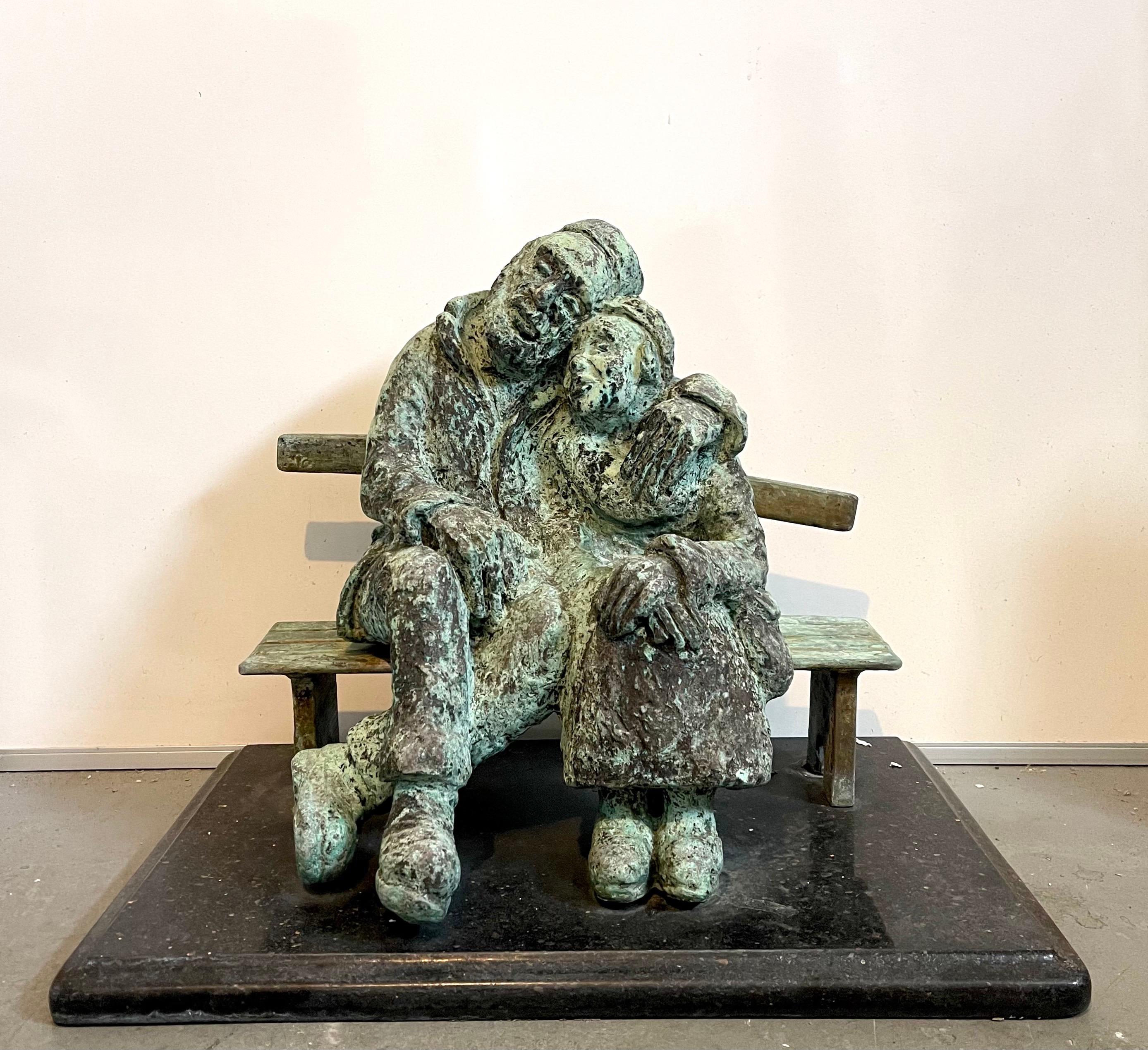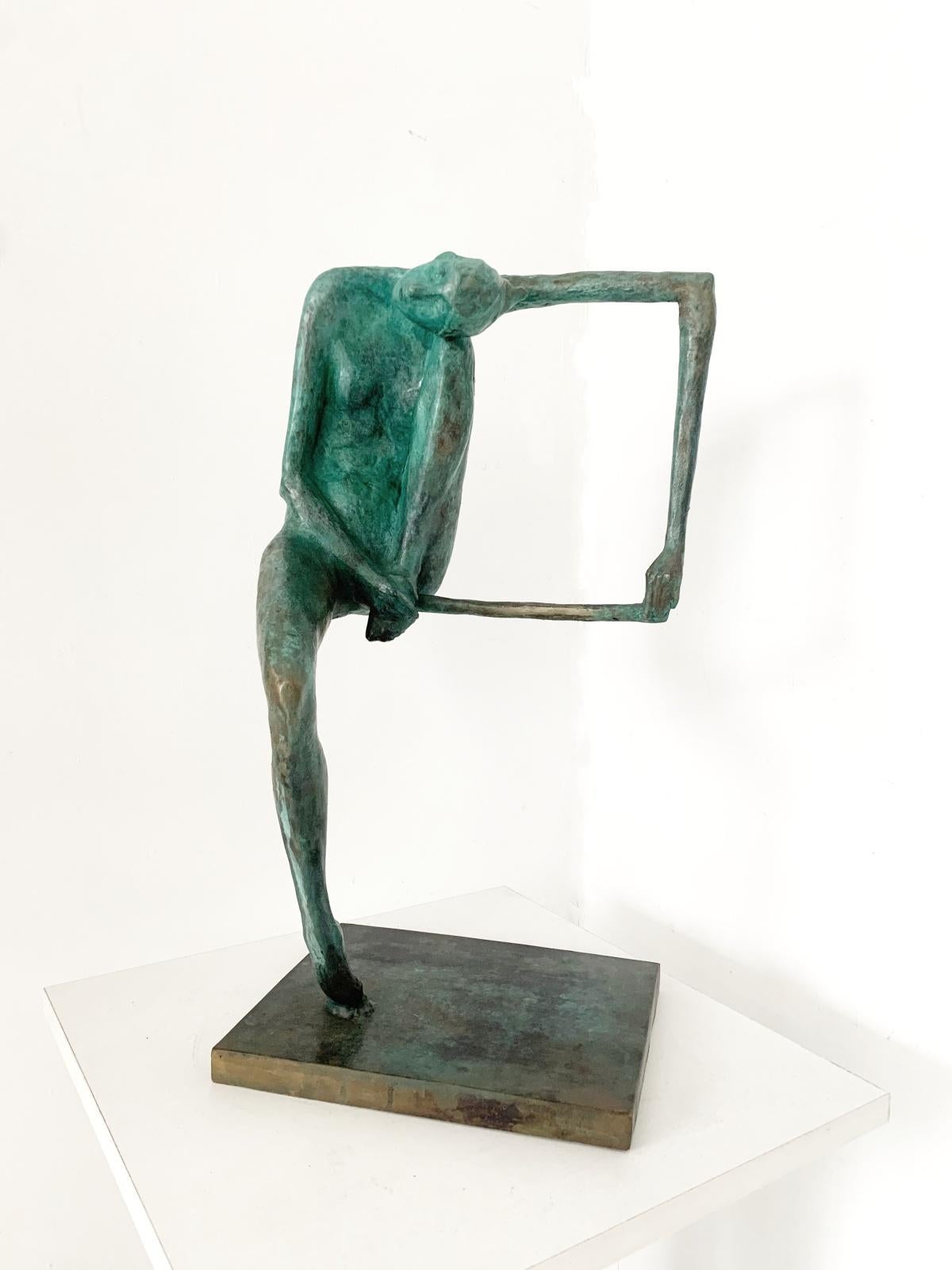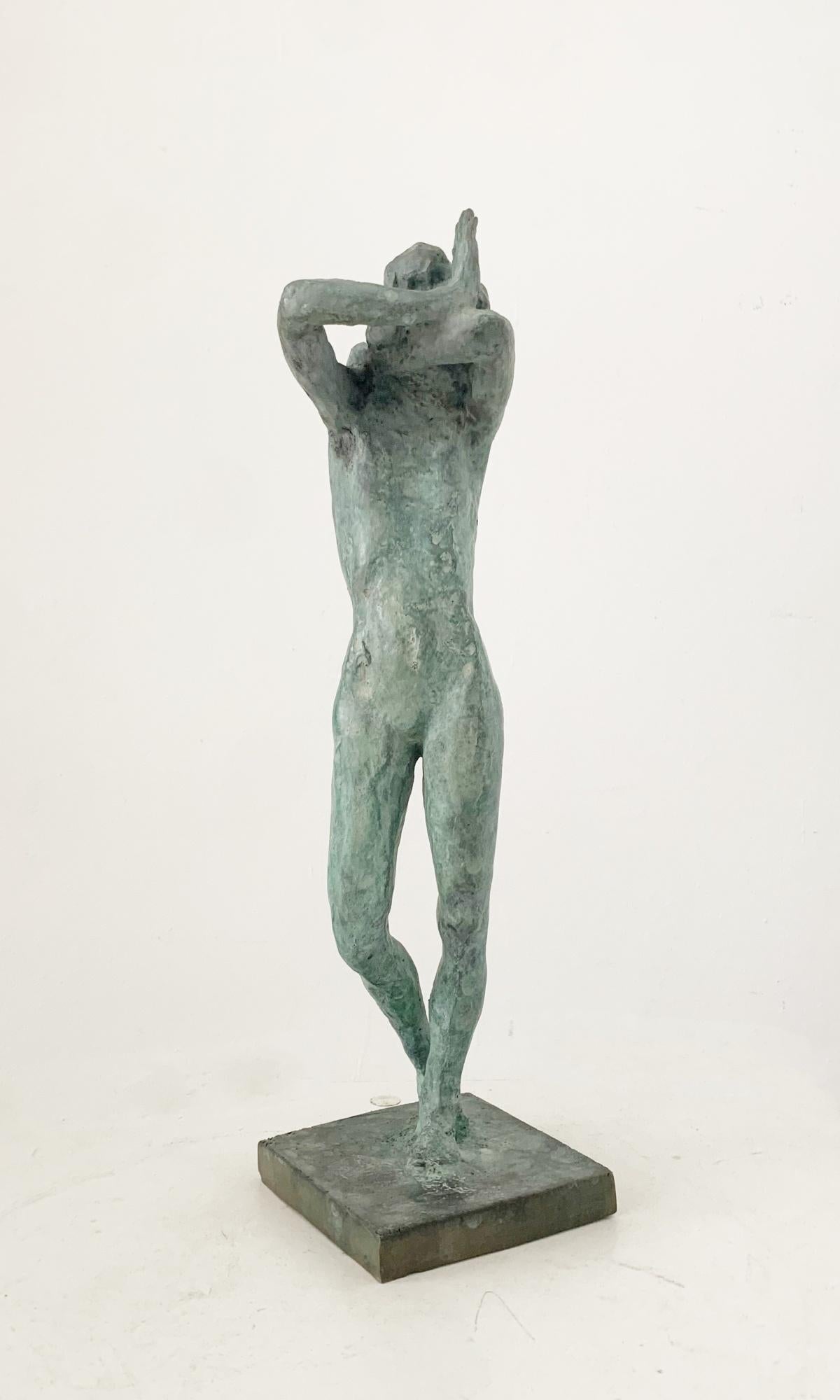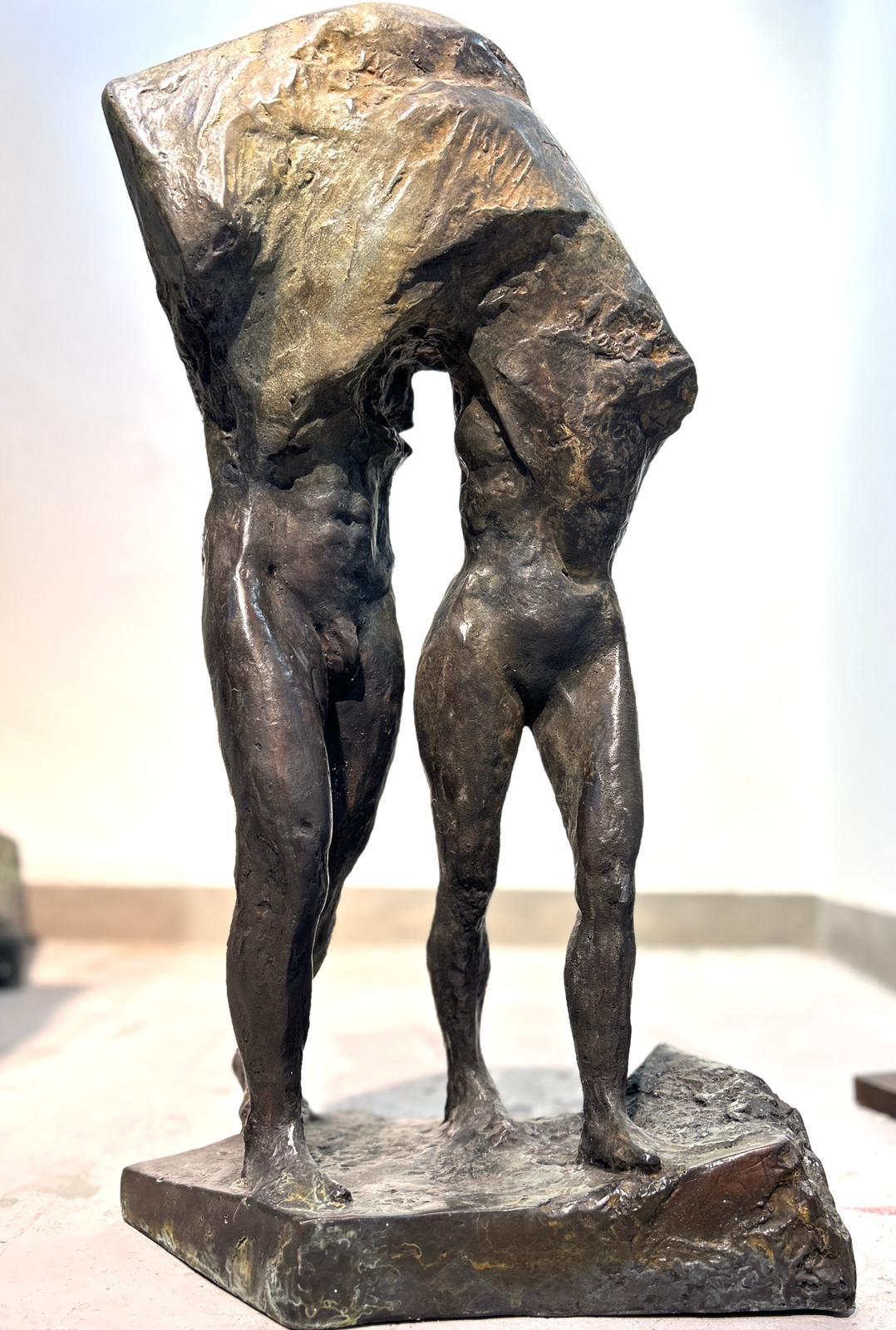Items Similar to How They Met Themselves By John Singer Sargent
Want more images or videos?
Request additional images or videos from the seller
1 of 7
John Singer SargentHow They Met Themselves By John Singer SargentEarly 20th century
Early 20th century
About the Item
John Singer Sargent
1856-1925 American
How They Met Themselves
Bronze
John Singer Sargent was among the most successful artists of his era. By the late 19th century, he was the most admired and sought-after portraitist across both Europe and America, and he was uniquely capable of conveying the style and elegance of the gilded age. While he is best known for his painted portraits, the artist excelled in various genres and media, but undoubtedly the rarest works of Sargent’s oeuvre are his sculptures. Although he completed very few sculptures in his career, Sargent demonstrated a meticulous devotion and enthusiasm for the medium, as expressed by the present bronze entitled How They Met Themselves.
Sargent began pursuing the art of sculpture beginning late in the 1890s. Although portraiture had brought him success and international acclaim, Sargent endeavored to find new inspiration around the turn of the century, proclaiming that he had “firmly decided to devote [himself] to other branches of art.” He expanded more and more into landscapes and figural works with a narrative quality.
The composition of this bronze is based on an iconic watercolor painting and drawing of the same title by the Pre-Raphaelite master, Dante Gabriel Rossetti. Sargent was a long-time admirer of the Pre-Raphaelites, Rossetti in particular. Rossetti’s own images of women were marked by a sensuality that served as an aesthetic inspiration to Sargent, and, according to his friend and biographer, Evan Charteris, Sargent kept an engraving of How They Met Themselves in his studio. Rossetti’s work depicts the dramatic moment two young lovers in medieval dress meet their supernatural counterparts in the woods, portending their deaths.
Saturated with poeticism, Sargent’s figures evoke the grand romanticism of the Pre-Raphaelites; their dramatic poses and solid modeling are a clear ode to his source image. For this work, Sargent wished to translate Rossetti’s superb two-dimensional modeling into a sculptural form. He greatly respected Rossetti’s technical ability, stating, “That is the difficult thing to do, anyone can paint, but to design a group so that it will — well, do in sculpture — that’s what counts. Rossetti could do it.”
Born in Florence to American parents, Sargent began his formal art training at the Academy of Fine Arts in Florence in 1871. In order to advance his education, the burgeoning artist moved to Paris to study at the École des Beaux-Arts from 1874 to 1878 under the great Emile Auguste Carolus-Duran. After a somewhat tumultuous start on the Paris art scene, the attention his work garnered at the Salon propelled Sargent to great success, and he exhibited there regularly. He quickly drew the attention of society’s elite, making Sargent one of the most fashionable and respected portraitists of the era. In addition to oil paintings, he also executed a number of watercolors, rapid charcoal portrait sketches he referred to as “Mugs,” and, of course, a select few sculptures, including reliefs for the rotunda of the Museum of Fine Arts, Boston.
As Sargent only began taking an interest in freestanding sculpture later in his career, they are incredibly rare, and this un-editioned series has only three other known examples. Another bronze casting of the present work resides in the Victoria & Albert Museum in London, underscoring its importance. Art historian Helen A. Cooper, an expert on American art who curated an exhibition of Sargent’s sculptures for Yale University Art Gallery in 2001 has said, “I feel sure that had he lived longer, Sargent would have made the full transition from painting to freestanding sculpture.” How They Met Themselves represents a fascinating aspect of the artist’s oeuvre that few have seen and a sought-after rarity in terms of Sargent’s works.
Early 20th century
8 5/8" wide x 6 3/4" deep x 11 3/4" high
- Creator:John Singer Sargent (1856-1925, American)
- Creation Year:Early 20th century
- Dimensions:Height: 11.75 in (29.85 cm)Width: 8.63 in (21.93 cm)Depth: 6.75 in (17.15 cm)
- Medium:
- Movement & Style:
- Period:
- Condition:
- Gallery Location:New Orleans, LA
- Reference Number:
About the Seller
5.0
Vetted Seller
These experienced sellers undergo a comprehensive evaluation by our team of in-house experts.
Established in 1912
1stDibs seller since 2013
13 sales on 1stDibs
Typical response time: 4 hours
- ShippingRetrieving quote...Ships From: New Orleans, LA
- Return PolicyThis item cannot be returned.
More From This SellerView All
- Vénus De Milo Aux Tiroirs By Salvador DalíBy Salvador DalíLocated in New Orleans, LASalvador Dalí 1904-1989 Spanish Vénus de Milo aux tiroirs (Venus de Milo with drawers) Signed "Salvador Dalí EA III/IV" (on base) Bronze One of the most famous sculptures of Salv...Category
20th Century Post-Impressionist Nude Sculptures
MaterialsBronze
- Winston Churchill Artist Proof Bust by Ivor Roberts-JonesBy Ivor Roberts-JonesLocated in New Orleans, LAIvor Roberts-Jones 1916-1996 British Sir Winston Churchill Artist Proof Bronze with a green patina One of the greatest leaders of the modern world, Winston Churchill is among the...Category
20th Century Figurative Sculptures
MaterialsBronze
- Laocoön And His Sons BronzeLocated in New Orleans, LALaocoön and his Sons Italian Bronze Group after Agesander, Polydorus and Anthenodorus Late 18th Century “The greatest piece of art in the world.” - Michelangelo, Italian sculptor, p...Category
Late 18th Century Baroque Figurative Sculptures
MaterialsBronze
- Sir Winston Churchill Memorial By Ivor Roberts-JonesBy Ivor Roberts-JonesLocated in New Orleans, LAIvor Roberts-Jones 1916-1996 | British Sir Winston Churchill Memorial Bronze This exceptional and iconic sculpture of Sir Winston Churchill is the original maquette for the renown...Category
20th Century Academic Figurative Sculptures
MaterialsBronze
- Married Love by Oscar NemonLocated in New Orleans, LAOscar Nemon 1906 - 1985 Croatian Married Love Signed “Nemon” (on reverse) Bronze resin with green patina This rousing and sentimental sculpture, commis...Category
20th Century Figurative Sculptures
MaterialsBronze
- Bronze of Pluto Abducting Proserpine after François GirardonLocated in New Orleans, LAAfter François Girardon 1628-1715 French Pluto Abducting Proserpine Bronze This High Baroque period composition captures the famed narrative of Pluto and Proserpine from Roman mythology. The late 17th-century patinated bronze, created after François Girardon's marble composition, captures the very moment that Pluto seizes Proserpine. The anguished goddess reaches skyward, attempting to escape the god’s grasp while Pluto’s stoic face betrays his knowledge that his ploy will succeed. This pivotal moment in the mythological tale has captured the imagination of many art historical greats, from Bernini to Rubens. François Girardon’s version of the climax demonstrates incredible finesse and artistry, modeled expertly in bronze in the present work by a later sculptor. The statue brings a twist of intertwined bodies into a dynamic frenzy, paralleling the tension of the legendary story. In ancient Roman mythology, Proserpine, the beautiful daughter of Ceres — known as Persephone in Greek mythology — was picking flowers in the fields when she was suddenly abducted by Pluto, the god of the underworld, and taken to his kingdom. Consumed with grief, her mother Ceres, the goddess of agriculture, scorches the earth, stopping the growth of grain and fruit. Jupiter attempts to intervene and secure Proserpine’s return to earth, negotiating a compromise with Pluto and the Fates that allows Proserpine to be released for part of the year before returning to Pluto’s underworld. Proserpine’s journey back and forth is an allegory for the changing seasons; when Prosperine is with her mother, the earth warms and provides bountiful harvests. Upon her annual return to the underworld, however, the earth once again becomes cold and barren. After returning to France after years of training in Rome, François Girardon quickly rose to become one of the greatest artists in France. He was elected a member of the Académie Royale de Peinture et de Sculpture in 1657 and would become Chancellor of the Royal Academy in 1695. The artist was approached frequently for royal commissions and Girardon’s Pluto was originally commissioned by Louis XIV for the gardens at his Palace of Versailles. It was one of four monumental marble groups intended to decorate the corners of Charles Le Brun’s never completed garden at the chateau, the Parterre d’Eau. Each group of three figures symbolized one of the four elements: earth, air, fire and water. Pluto’s association with hell made him the apt...Category
Early 18th Century Baroque Figurative Sculptures
MaterialsBronze
You May Also Like
- Heavy Bronze Sculpture Austrian Israeli judaica Jewish Couple Bench Nicky ImberBy Nicky ImberLocated in Surfside, FLLarge and heavy with magnificent patina. This is the large version of this piece. we cannot find any markings on it and it might be unique. Nicky Imber (Vienna, Austria, 1920 -1996) was a multidisciplinary Jewish artist best known for his sculptures on Jewish themes. Grand nephew of Naftali Herz Imber, author of the Israeli national anthem 'Hatikva'. After escaping the Nazi concentration camp in Dachau, he pledged to dedicate his art to perpetuating the memory of the Holocaust. Among his more famous works are "The Hope" and "The Love of Torah". His work can be seen around the world, in Northern Israel, the United States, and the Venezuelan Museum of Natural History in Caracas. Nicky Imber was born in Vienna, Austria. During his studies at the Academy of Arts in Vienna, he drew anti-Nazi caricatures for Jewish student publications. After several thwarted attempts by the family to leave Vienna, in 1938, in the wake of the 'Anschluss', Imber was deported to Dachau. Witnessing the murders of family and friends, he plotted his escape. Using skills he had learned in art school, he made a face mask out of bread and sand, stole a Nazi soldier's uniform and walked out the front gate unnoticed. In 1940, he boarded a ship...Category
Mid-20th Century Post-Impressionist Figurative Sculptures
MaterialsMarble, Bronze
- A woman. Contemporary figurative bronze sculpture, Polish art, Limited editionLocated in Warsaw, PLLimited edition bronze sculpture by Polish artist Olga Prokop-Misniakiewicz. Artist signes her artworks by hand, using engraving tool. Edition of 5. Olga Prokop-Misniakiewicz likes t...Category
2010s Post-Impressionist Figurative Sculptures
MaterialsBronze
- On a carpet hanger. Figurative bronze sculpture Polish art, Limited editionLocated in Warsaw, PLLimited edition bronze sculpture by Polish artist Olga Prokop-Misniakiewicz. Artist signes her artworks by hand, using engraving tool. Edition of 8. Olga Prokop-Misniakiewicz likes t...Category
2010s Post-Impressionist Figurative Sculptures
MaterialsBronze
- A woman. Contemporary figurative bronze sculpture, Polish art, Limited editionLocated in Warsaw, PLLimited edition bronze sculpture by Polish artist Olga Prokop-Misniakiewicz. Artist signes her artworks by hand, using engraving tool. Edition of 5. Olga Prokop-Misniakiewicz likes t...Category
2010s Post-Impressionist Figurative Sculptures
MaterialsBronze
- Expulsion from Paradise. Figurative bronze sculpture Polish art, Limited editionLocated in Warsaw, PLLimited edition bronze sculpture by Polish artist Olga Prokop-Misniakiewicz. Artist signes her artworks by hand, using engraving tool. Edition of 8. Olga Prokop-Misniakiewicz likes t...Category
2010s Post-Impressionist Figurative Sculptures
MaterialsBronze
- Cylindre au Christ aÌ l'IdoleBy Paul GauguinLocated in Long Island City, NYA bronze sculpture after Paul Gauguin cast from a 1894 original wood carving. It is a wonderful example of his Primitivist style likely influenced by the Polynesian art...Category
Mid-20th Century Fauvist Figurative Sculptures
MaterialsBronze
Recently Viewed
View AllMore Ways To Browse
Kaws Garfield
Melting Clock Watch
Porcelain La Pieta
Portrait Miniature On Porcelain Early American
Powell Peralta
Ramirez Manuel
Richard MacDonald On Sale
Richard Macdonald Bronze Sculpture Rain Atelier
Ross Redmon On Sale
Salvador Dali Bas Relief Silver
Sculpture Joe Namath
Shrigley Serpent
SOPHIE MARTIN On Sale
Stickley 21st Century
Subrata Biswas On Sale
Sydney Kumalo
T Rex Skull
Teapot Kaws




